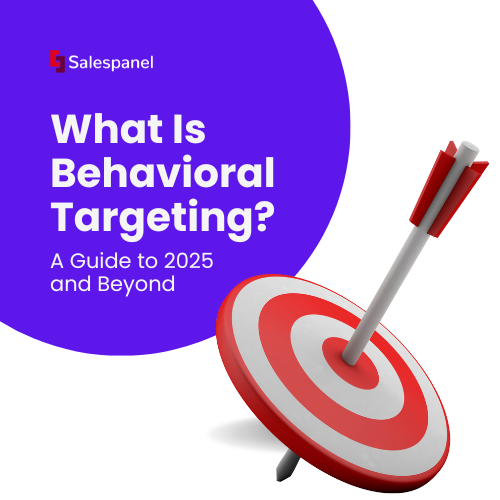What Exactly Is Consent Management?
As we engage with the digital world, our interactions often leave a trail, browsing products, clicking ads, or even scrolling on a blog. Behavior information is tracked through cookies, pixels, or embedded scripts. These technologies help to power analytics as well as advertising, and raise privacy and control issues.
This is where consent management comes into action.

In simple terms, consent management refers to how websites and applications (mobile and desktop apps) acquire and manage users’ permissions to collect, utilize, and share their personal data. Consent management is whether users get a choice to say “yes” or “no” to being tracked, and to ensure that technology is functioning as the user has chosen. It also means respecting users’ choices behind the scenes, especially when third-party vendors are involved.
The concept of consent isn’t new. Long before digital cookies existed, asking for permission before collecting personal information was common practice in healthcare, research, and legal contexts. However, in today’s world, where a single visit to a website can trigger the transfer of data to numerous third-party platforms, managing consent is more vital than ever, and much harder technologically.
A well-implemented consent management process typically includes a few things:
- Users can actively choose to opt-in or out through visible, accessible mechanisms like cookies banners and pop-ups.
- There is a strict enforcement system that ensures no non-essential trackers are activated prior to receiving consent.
- A secure method for storing consent for record-keeping and audits.
- Users can revisit and adjust their preferences anytime.
Regulations like the GDPR in the EU and the CCPA in California have made it mandatory for companies to request explicit permission before tracking users. Ignoring user consent comes with great risks. With fines, damage to public trust, and loss of reputation on the line, ignoring user consent is a foolish move.
Aside from the legal aspects, there is an emerging expectation from users: They expect to be informed regarding data collection. Users want to be informed about the collection of their data, and they wish to have control over it.
Thus, in this post, when we refer to consent management, we mean more than the infamous cookie banners. We are still dealing with constructing systems that demonstrate respect for user privacy and control, comply with international privacy regulations, and work well with the digital infrastructure that drives modern enterprises.
Beyond Cookies: The Full Scope of Consent Management
Rather than being confined to websites and cookies, consent management’s true scope is far greater. It applies to all situations where personal data is collected, stored, and processed, especially if the data has the potential to be linked to an identifiable individual.
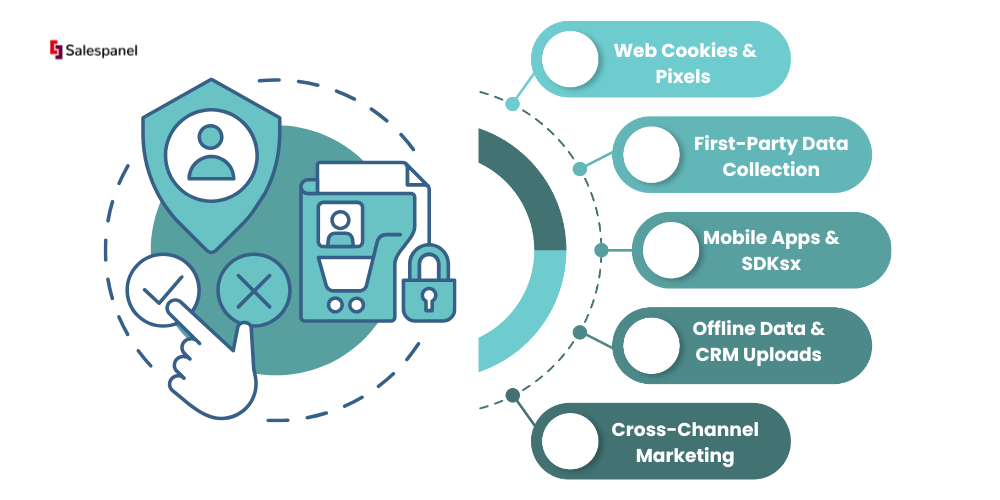
Cookies are merely the most blatant portion of the tip of the iceberg. The larger picture involves first-party data, marketing automation, CRMs, email marketing, mobile applications, SaaS tools, and even offline data collection. Let’s explore.
1. Web Cookies & Pixels (Most Common)
Cookie consent is the starting point for most businesses. Tracking pixels and retargeting scripts, not to mention analytics tools like Google Analytics, Meta Pixel, and Salespanel, all fit within this category. These tools tend to drop tracking cookies that gather behavioural information. Laws like GDPR require that users provide explicit consent before non-essential cookies are activated.
But this is only one aspect of the puzzle.
2. First-Party Data Collection
First-party data refers to any information a business gathers from its customers directly. This can include:
- Email addresses gathered from subscriptions to newsletters
- Phone numbers from lead generation forms
- Purchase history
- Support chat transcripts
- Survey responses
When gathering this type of data, you need to explain what the motivations behind the data collection are, how it will be used, and, in most cases, securing explicit consent for certain uses, especially if profiling or marketing is involved.
A few common scenarios:
You cannot automatically email market someone who signed up for a free trial without their explicit permission.
Tracking product usage within your SaaS application for upsell prompts might fall under personal profiling as defined by GDPR laws. This may necessitate explicit consent or, at a minimum, a legally acceptable rationale such as legitimate interest.
3. Mobile Apps & SDKs
Mobile applications do not apply cookies in the traditional sense used within browsers, but they frequently utilise SDKs (Software Development Kits) which collect and transmit user data to third parties, such as:
- Location tracking and tracking
- Device IDs collection
- Behavioral analytics
- Advertising related identifiers
Mobile app consent management includes displaying permission prompts and sharing data with outside entities. Compliance with Apple and Google’s stricter privacy enforcement makes managing consent within mobile applications mandatory.
4. Static Data and Offline Data Uploads to CRM
Static or semi-static data, such as trade show leads, phone survey results, and CSV files uploaded to your CRM, are not exempt from consent scrutiny.
When uploading leads to a CRM and retargeting them on LinkedIn or Facebook using Custom Audiences, the source of the data and whether proper consent was obtained is crucial.
An adequate consent management plan must keep track of the following: A proper consent management strategy needs to track and store:
- When and how the data was collected
- What was the user informed about regarding the data collection?
- The specific agreement made (e.g., “Contact me about your product” as opposed to “Send me promotional offers.”)
5. Cross-Channel Marketing (Email, SMS, WhatsApp, etc.)
Every email or SMS sent must observe the relevant channel-specific regulations.
- Email: CAN-SPAM (US), PECR (UK), GDPR (EU)
- SMS: TCPA (US) and DND rules (India)
- WhatsApp/Business Messaging: Meta requires opt-ins before promotional messages
Consent in these channels must be highly detailed. A catch-all “Yes” to all marketing options is insufficient, as users must indicate what type of messages they wish to receive and through what channel.
Thus,
While the ability to manage cookie consent may have started the conversation, complete consent management truly spans the entire data lifecycle, including web, mobile, email, CRM, advertising platforms, and even offline sources. It’s about providing users transparency and control over their data, irrespective of the methods and locations used to collect the information.
For B2B marketers, the conversation must move beyond the cookie banner. That means everything from your website, lead forms, CRM systems, email tools, and advertising platforms has to function under one consent-focused compliance system.
Companies need more than just a basic consent banner; they need the ability to manage consent deeply and intelligently. CMPs are the operational backbone for enforcing data permissions across the entire digital ecosystem, making them the perfect fit for this role. Let’s discuss it!
What Is a Consent Management Platform (CMP)?
A Consent Management Platform (CMP) is software designed to help organisations manage compliance with privacy laws and regulations for capturing, keeping, and enforcing data subject consent on digital properties such as websites, apps, and other customer interaction portals.
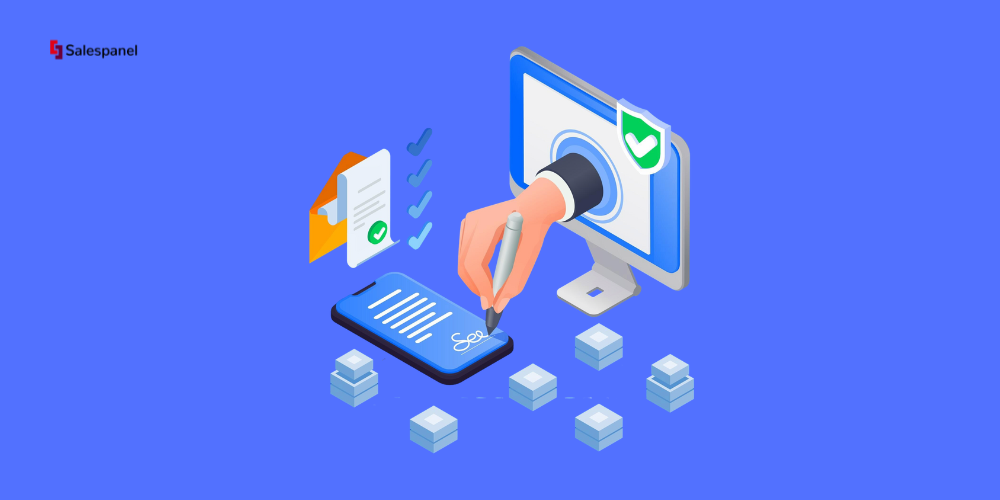
We sincerely hope that your team member’s understanding of a CMP is not limited to “cookie popups,” because a CMP is so much more than a polite pop-up asking for permissions. It is an umbrella term for a complete system of enforcement—one that maintains compliance, keeps your tools in check, ensures data hygiene, and lets your legal counsel breathe easy.
As the core control unit of consent management, it ensures users are notified, can provide, or deny various levels of tracking or processing, and control over data processing for each individual.
The defining feature of CMPs is the capability of enforcing consent. The CMP becomes the gate through which your users interact with your data collection stack. For example, if a user does not provide consent for marketing or analytics cookies, those tools will be actively blocked until consent is provided.
What Do CMPs Actually Do?
Now, let’s examine the five core functions of a Consent Management Platform in detail.
1. Consent Collection
This is the most visible function — when you land on a website and see a banner asking for cookie permissions, that’s the CMP in action.
A good CMP ensures that:
- Consent is informed (the user knows what they’re agreeing to)
- Consent is freely given (no dark patterns or forced actions)
- Consent is granular (users can accept analytics but reject marketing, for example)
- Consent is revocable (users can change their mind later)
Banners can range from simple “Accept/Reject” buttons to more detailed preference centers that allow users to toggle individual tracking categories or vendors.
The UI/UX of this experience matters — it affects opt-in rates, user trust, and legal defensibility.
2. Consent Enforcement
This is the CMP’s moment of truth — it not only captures the user’s decision but actively enforces it.
That means:
- Until a user opts in, no tracking or third-party scripts should run.
- Tools like Google Analytics, Facebook Pixel, or Hotjar are conditionally triggered based on the user’s choices.
- Your CMP integrates seamlessly with tag managers, native JavaScript APIs, or plugins to manage script activations.
- If a user opts out of marketing cookies, your CMP guarantees that:
- Your Facebook or Google Ads remarketing pixels are blocked.
- No custom audiences are generated from that session.
- The decision is upheld until the consent record expires (usually 6 to 12 months, depending on the region).
This capability shifts compliance from mere checkbox recording to live, responsive control systems.
3. Consent Logging and Record-Keeping
Under regulations like GDPR, businesses must not only collect consent but also provide evidence of collection processes if challenged.
CMPs have a log of consent which includes:
- What the user was shown
- What they agreed to (or rejected)
- When the action occurred: timestamp (and associated geolocation, IP, device, browser)
- Timestamped geo-location data of where the user was when they interacted (IP, device, browser)
- The version of the privacy notice or consent banner at that time
This data becomes your compliance audit trail and is invaluable during regulatory scrutiny.
Some CMPs even offer automated jurisdiction-based backups (e.g., storing data of EU users on EU servers).
4. Managing User Preferences
Consent is not a single event; users should be able to review their preferences at any time and have the freedom to change them.
CMPs assist with:
- Let users adjust privacy settings at any time (often found in website footers).
- A dedicated section where users can review and modify their consent settings.
- Change tracking so that every system responds instantly to altered preferences.
As an example, let’s say a user consents to receive marketing emails. If this user later opts out of using your CMP, that preference will be updated across systems, including:
- Your email marketing tool (Mailchimp, Sendgrid, etc.).
- Your CRM or CDP.
- Advertising platforms are removing the user from remarketing lists.
Syncing consent status this way is one of the most intricate and important aspects of data governance today.
5. Support for Multiple Platforms and Regions
Today’s CMPs are designed to manage consent not only on websites but also:
- In mobile applications (managing SDK permissions)
- Through cross-domain and multilingual support
- Using geolocation-aware functions (e.g., showing rigorous GDPR-style banners solely to EU users)
- Through embedded forms, email capture widgets, or offline data gathering (manual uploads containing consent fields)
This implies that a single CMP can apply policy changes based on:
- The location of your visitor
- The device in use (web, mobile, or application)
- Applicable legal frameworks for your company or industry
To summarise, the CMP automates the processes around managing user data rights with compliance framework requirements. It centralises all control into a single point to manage specific processes for integrated systems, technology, user experience, as well as compliance.
How CMPs Work Together with Marketing and Analytics Tools
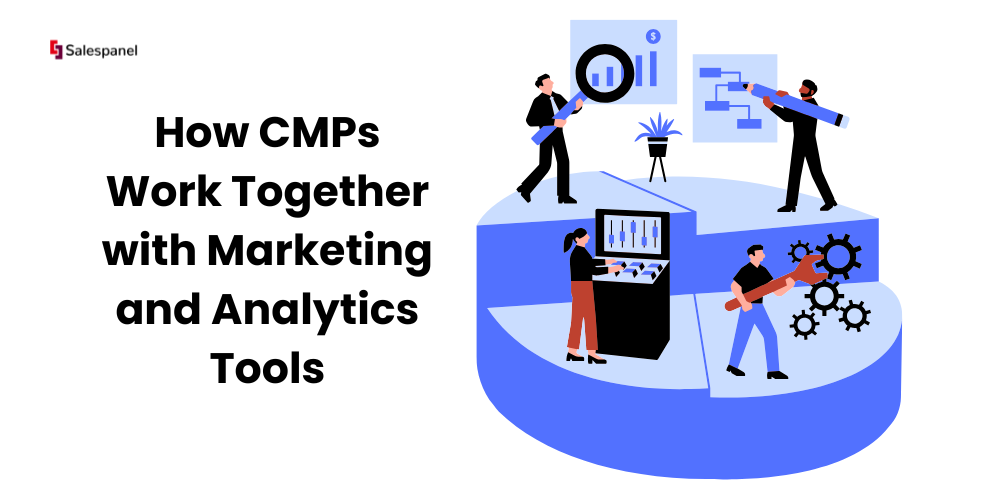
A good number of modern websites are powered by a complex mix of different tools like analytics platforms, A/B testing, retargeting scripts, heatmaps, chat widgets, CRMs, and more. These tools need access to visitor data, sometimes anonymously and other times not. In the absence of a consent framework, these tools begin tracking as soon as a page is loaded. In this post, we will look at how CMPs interact with the major categories of tools.
Google Analytics & Tag Managers
Collectively, Google Analytics and GA4 track users via cookies across sessions and devices. Under GDPR and similar regulations, collecting this data, even through anonymisation, often requires consent. With a CMP in place, the initial GA script is blocked or suppressed until the user opts into analytics tracking.
Most CMPs do not block scripts by default. Instead, they integrate through Google Tag Manager (GTM), which allows marketers to contain each tag within conditional logic. For example, a GA4 tag may fire only if consent.analytics == true. Several CMPs also support Google Consent Mode. These CMPs let you run GA4 in a limited mode without full consent, allowing compliant modelling of missing data.
Failure to comply with privacy laws would lead to misfiring tags and collecting data unlawfully.
Advertising Platforms (Google Ads, Meta Pixel, LinkedIn, etc.)
Because consent is crucial to these platforms, they track users across multiple websites. This goes against privacy laws and is, therefore, a sensitive matter for advertisers.
When visitors access a website that has Meta Pixel or Google Ads remarketing tags, they are likely to receive ads on Facebook and Google Search. However, this type of targeting is not available in certain areas without users explicitly opting in.
CMPs do not allow the pixels to load without marketing consent. Also, Google now mandates businesses to implement Consent Mode v2, which requires integration with certified CMPs for audience creation and conversion tracking in Europe. Failure to comply results in losing crucial advertising features.
In simpler terms, ads can be active and running, but there is a high chance that tracking, attribution, and custom audiences would not work.
CRMs and Customer Data Platforms (CDPs)
Salesforce or HubSpot as CRMs and Segment or RudderStack as CDPs do not drop cookies by themselves. However, they become part of the consent ecosystem when user data is linked to marketing automation or sales workflows.
In case a user submits a lead form, and your system decides to:
- Send them marketing emails
- Push their behaviour into a CDP for segmentation
- Use their data in retargeting campaigns
You need to track and enforce consent status at the contact level, not at session level. A CMP can capture that consent decision and pass it to your backend or CRM system using a webhook or API. This decision makes sure that subsequent actions, like email sends, lead scoring, and sales outreach, are compliant with the user’s data privacy settings.
Some other systems, like HubSpot, provide basic consent settings. These tend to be shallow and do not replace a full CMP system. This is particularly true for cookie handling and third-party tools.
Email and Messaging Tools
Services like Mailchimp, Klaviyo, and SendGrid require marketing emails to have opt-in confirmation. A CMP makes sure that when a user opts into communication via a form or preference centre, that preference is complied with and logged, stored, or pushed to the email platform as necessary.
Also, it offers a consolidated mechanism for withdrawal of consent. If a user opts out through privacy controls on your site, the email system should reflect that change instantly. Not doing so may result in sending emails without permission, which is a compliance violation.
Other Frontend Tools: Chat, Heatmaps, A/B Testing
Many companies use Hotjar, Crazy Egg, Drift, or Intercom. These tools can be overly data-rich and intrusive. For instance:
- Heatmap tools may track and record mouse clicks and movements.
- Chatbots may ask for personally identifiable information such as email addresses or phone numbers.
- A/B testing platforms set cookies to segment users and persist experiments.
CMPs work to enforce consent for these as well, usually by restricting script loading or tag execution based on preferences. Without that enforcement, even a single page view could lead to unauthorised data collection.
Salespanel and Consent-Aware Tracking
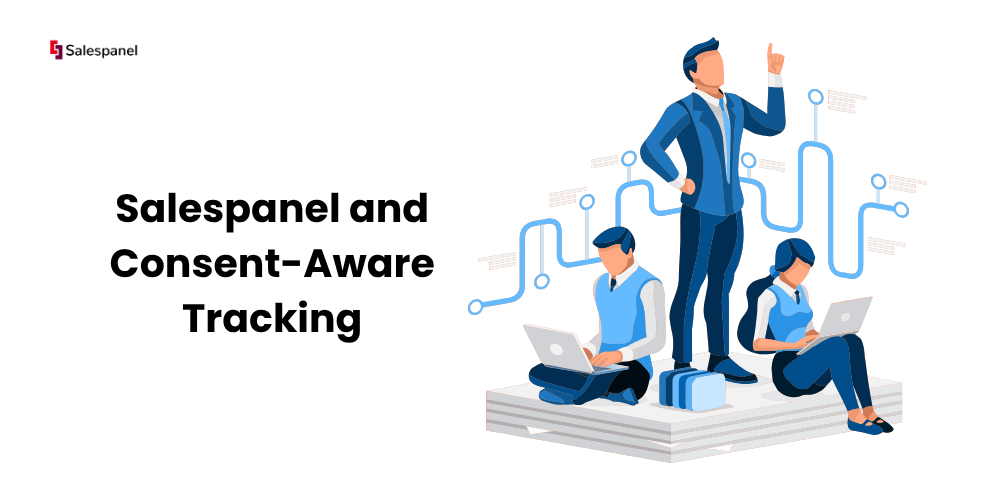
With privacy regulations changing how businesses collect and use customer data, tools can no longer operate independently of consent frameworks. They must respond to them, and this is where Salespanel has built thoughtful compliance into its tracking architecture.
Salespanel is designed to integrate with Consent Management Platforms (CMPs). It identifies the presence of a CMP and goes into a stand-by mode until the proper signal is given. This ensures that no tracking takes place unless user consent is given, in alignment with regulations like GDPR, CCPA, and others.
For businesses that want more control, Salespanel offers an “Activate on Demand” mode. In this mode, tracking is completely off until your CMP sends a verified consent signal. This structure is best for organisations that have advanced consent configurations or custom setups, because it allows full control over the activation of tracking.
More integration steps can be found in Salespanel’s official compliance documentation, which guides teams through setting up compliant tracking flows while maintaining data accuracy and marketing efficiency.
Basically, Salespanel solves the problem of balancing privacy and performance for B2B marketers by providing a user-friendly solution where privacy rights are respected, yet powerful intent tracking and lead qualification are still possible.
How Businesses Perceive CMPs: A Business Lifecycle Overview
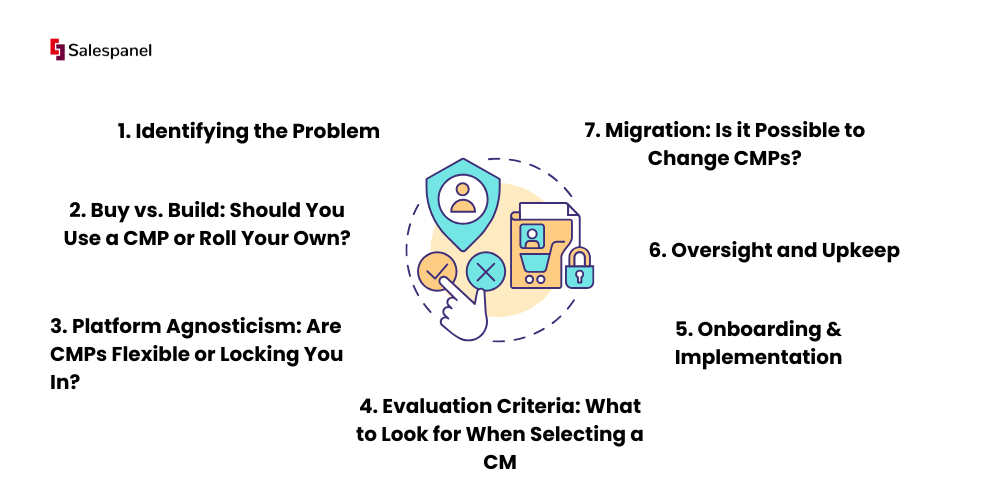
1. Identifying the Problem
In most cases, a business does not begin with a Consent Management Platform (CMP) but rather adopts one after they hit a compliance wall or warning signs. These markers are often cross-border traffic, which indicates the potential for visitors from the EU or California, meaning GDPR or CCPA considerations.
Your legal or compliance team signalling a red flag regarding tracking without consent also serves as a moment to adopt CMP Technologies.
Google Consent Mode and IAB TCF becoming mandatory for your ad campaigns also serves as a moment to shift towards CMP Technologies, especially for those who need personalised targeting.
Failing privacy audits or being flagged by tools like Cookiebot or Osano’s compliance scanners serve as wake-up calls.
Or if users begin to ask about their privacy rights, prompting internal dialogue concerning ethical data collection.
The moment your privacy compliance officer starts whispering “I told you so” is when a CMP categorically shifts from being a “nice to have” tool to a “must have” tool.
2. Buy vs. Build: Should You Use a CMP or Roll Your Own?
This second decision involves weighing the options between an “off-the-shelf” platform and building one from scratch. Quite often, tech-savvy teams are tempted to go the DIY route, but that’s seldom a good idea.
Building In-House
Pros:
- Full control over the user’s workflow, user interface, and user experience (UI/UX) and how it integrates with other systems.
- It could be efficient if your needs are small and localised.
Cons:
- Responsible for all changes legislatively, updating, interpreting laws, or changing jurisdictions.
- No automated audit trail, consent versioning, or policy sync.
- Blocking tags and managing consent preferences becomes a custom engineering burden.
- Like building your own payment gateway — possible, but not advisable unless it’s your core product
Buying a CMP
Pros:
- Comes regulation-ready — supports GDPR, CCPA, LGPD, and more out of the box.
- Offers pre-built integrations, APIs, and tag manager support.
- Includes legally defensible consent logging and audit trails.
- Easier to scale and demonstrate compliance, especially to auditors or partners.
- Multi-language support, geo-based banner rules, and preference centres all come as standard features.
Cons:
- Subscription fees, which are commonly set around page views or MAUs.
- Some degree of vendor lock-in, particularly with proprietary formats.
- Customisation may be limited on lower-priced plans
Takeaway: Purchasing a CMP is often more practical and future-proof for businesses, especially those with global traffic or plans to scale.
3. Platform Agnosticism: Are CMPs Flexible or Locking You In?
The majority of modern CMPs are designed to be platform agnostic, meaning they integrate into multiple ecosystems:
- CMS systems such as WordPress, Shopify, or Webflow.
- Frontend frameworks like React, Vue, or custom sites.
- Mobile app backends (Android, iOS) using tag managers or native SDKs.
- But “agnostic” doesn’t always mean “portable.”
What businesses should ask themselves before deciding:
Is it easy to export consent logs?
If value-added services are used, can consent preferences be changed to another provider without breaking?
Prior to ad tech integration, does it support IAB TCF 2.2?
Can scripts be self-hosted (as opposed to relying on third-party CDN scripts like Cookiebot)?
A good CMP offers:
- Well-documented APIs for retrieving and capturing consent.
- Portability of vendor lists.
- Self-contained script block and tag manager-based classification that aids cleaner migration later.
4. Evaluation Criteria: What to Consider While Choosing a CMP
Finding a CMP that works for you requires much thought. It needs to fit your technology stack, brand identity, and legal considerations.
Here are some of the evaluation criteria that go into it.
- Compliance coverage: Does it support GDPR, CCPA, LGPD, and others?
- Customizability: Can you design the banner so that it matches your site’s aesthetic and will not scare users away?
- Tag/script control: Does it integrate with GTM or provide options for manual tag blocking?
- Geolocation logic: Is it possible to display different banners to different regions?
- Reporting & audit logs: Can you obtain legally defensible records of consent?
- Integration depth: Does it connect with your analytics, CRM, CDP and other tools?
- Pricing model: Does its usage, features, or domain count scale fairly?
5. Onboarding & Implementation
Starting from the decision to a CMP, the organisation can expect it to take 3 days to a week for implementation. This is typically for moderately complex organisations.
The general onboarding steps consist of:
- Adding CMP codes through GTM or within the section of the website.
- Creating categories for consent, like Essential, Analytics, Marketing, etc.
- Assigning scripts or tags to the appropriate categories.
- Creating the banner experience involves phrasing, design, opt-in procedures, and logic steps.
- Setting geo-targets to show banners to users from different locations, like the EU and the US.
- Connection with external systems like Google Consent Mode or Meta Pixel requires integration.
- Before going live, make sure to test the flow on all devices, as testing is critical.
This stage is usually the intersection of marketing, engineering, and legal, which means cross-disciplinary collaboration becomes key.
6. Oversight and Upkeep
The launch of a CMP banner doesn’t mark the end of consent; CMPs need ongoing upkeep:
- If you are adding a new tool, it will automatically need categorisation. This may require you to perform a cookie scan.
- Privacy laws change, meaning any privacy texts or consent flows may require legal assessments.
- Analysing the performance of opt-in versus opt-out rates will help assess banner performance.
- Track and maintain the consistency of the consent preferences with the CRMs and CDPs.
- After changes are made to a site, watch for tools firing consent leaks where they begin executing before permission is granted.
To monitor consent trends and compliance health by regions, most CMPs offer dashboards for tracking.
7. Migration: Is it Possible to Change CMPs?
While it is possible to switch, it is not as simple as it sounds. It takes just as much effort to plan and clean up as it does when switching from one CRM to another.
- Before switching, make sure all scripts are categorised and categorised under the new platform.
- Decide what to do with the legacy consents: carry them forward or ask users to re-consent.
- For compliance continuity, export and archive the logs from the old CMP.
- Verify integrations, including analytics, ad pixels, and custom scripts, to ensure everything will function post-update.
Pro tip: If your scripts are executed via GTM and your user data is managed in a CDP, centralised data management makes migration significantly smoother.
Best Picks for Consent Management Platforms
The CMPs (Consent Management Platforms) market is overly saturated, and yet, not every tool demonstrates the same level of quality. While most tools provide basic compliance features, only a few demonstrate reliability, flexibility, and a strong long-term outlook.
For most businesses, especially those with international traffic or integrated ad stacks, going with an established, standards-compliant CMP is the safest path. Here are our top recommendations:
- OneTrust remains the go-to choice for large enterprises and teams with complex governance needs. It’s robust, highly customizable, and includes advanced privacy ops features well beyond cookie management. The trade-off? It’s expensive and can feel heavy for smaller teams.
- Usercentrics offers a great middle ground — strong compliance coverage, modern UX, and integration with IAB TCF for advertising. It’s ideal for mid-sized businesses that want control without enterprise bloat.
- Cookiebot (by Usercentrics) is lightweight, automated, and incredibly easy to deploy. It’s perfect for smaller websites or marketing teams that want fast, no-fuss compliance.
- Osano stands out for its transparency and simplicity. It offers vendor risk monitoring along with consent tools, making it a great pick for businesses concerned about third-party compliance.
- Iubenda works well for small businesses and startups, particularly for companies looking for assistance in drafting legal documents. Though it may not be the best in advanced consent logic, it does well for more basic applications.
All of these platforms provide support for geo-targeting, script blocking, audit logs, and integration with Google’s Consent Mode and Meta Pixel. These are all key features for modern compliance. The choice between these platforms depends on traffic scale, tech stack, and the amount of legal risk your business faces.
Quick Comparison Table
| CMP | Best For | Key Strengths | Considerations |
| OneTrust | Large enterprises | Feature-rich, customizable | Pricey, steep learning curve |
| Usercentrics | Midsize businesses | IAB support, flexible setup | Can get costly at scale |
| Cookiebot | Small to midsize sites | Automated, easy to deploy | Limited design flexibility |
| Osano | Compliance-focused SMBs | Vendor monitoring + simplicity | Lacks deep customisation |
| Iubenda | Startups and small teams | Legal docs + basic consent | Less control over granularity |
Final Thoughts
We understand this is a lot of information. However, simplifying too much can lead to costly mistakes when dealing with consent management. We have noticed a lack of thoughtful implementation and misinformation, which is why we aimed to cover everything systematically, step by step.
When it comes to privacy and consent, there is more to it than ticking a box. Just like a handshake, it serves as a trust signal from your audience. As with any growing industry, privacy laws will continue to evolve, making it ever more important to address user expectations. Treating consent management as a one-off box-ticking compliance activity is a surefire way to get exposed in the long run.
Your architecture now spans websites, CRMs, analytics, advertising, email, and even CRMs, all initially sparked by a simple cookie banner. From a startup gathering emails to an enterprise handling global ad campaigns, proper consent handling is inevitable on both legal and strategic fronts.
CMPs now cater to every stage and scale, from OneTrust serving the enterprise powerhouses to agile Cookiebot and Osano. Your exposure, technology, and traffic will help you hone in on the perfect fit, but the end goal remains consistent: user empowerment while staying compliant and upholding trust.
Having a consent management system is not a single setup task. It must evolve as technology changes, laws shift, and your company expands. Adapting to these changes will not only prevent harm but also create loyalty by doing the right things.
The bare minimum businesses can do is comply with the laws. Going the extra mile allows businesses to build trust, which is earned



